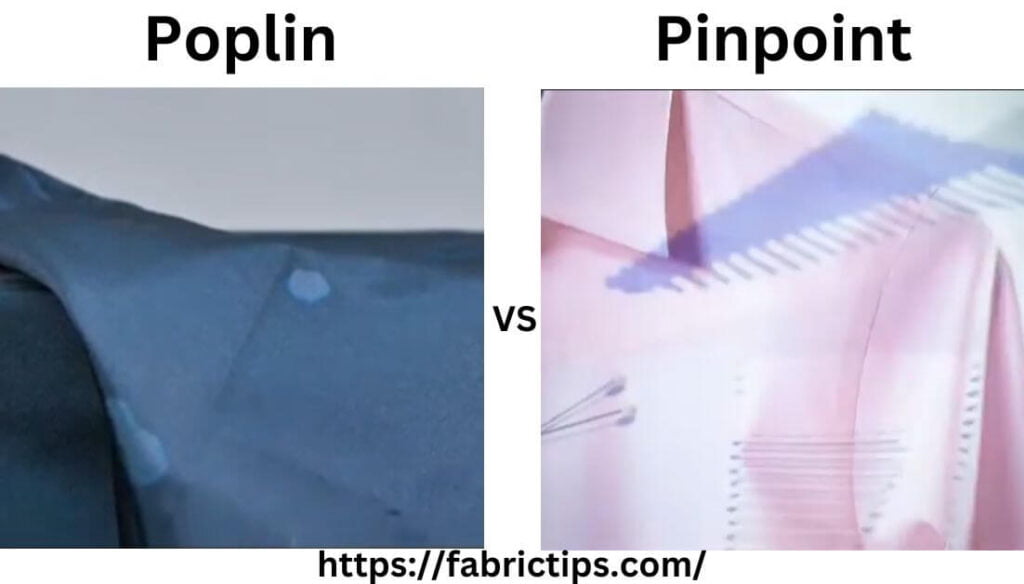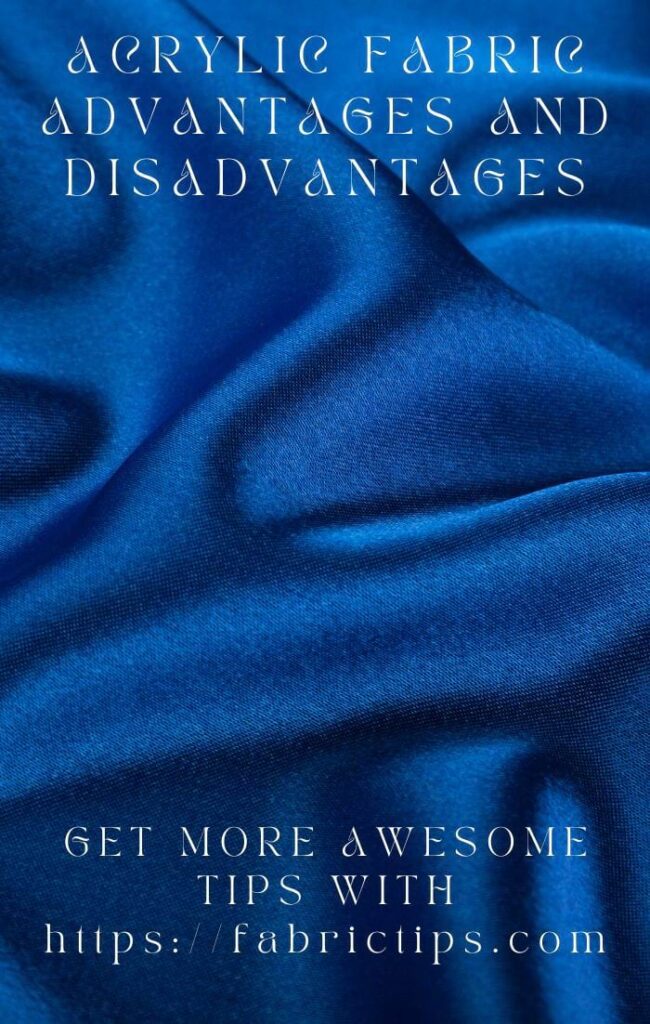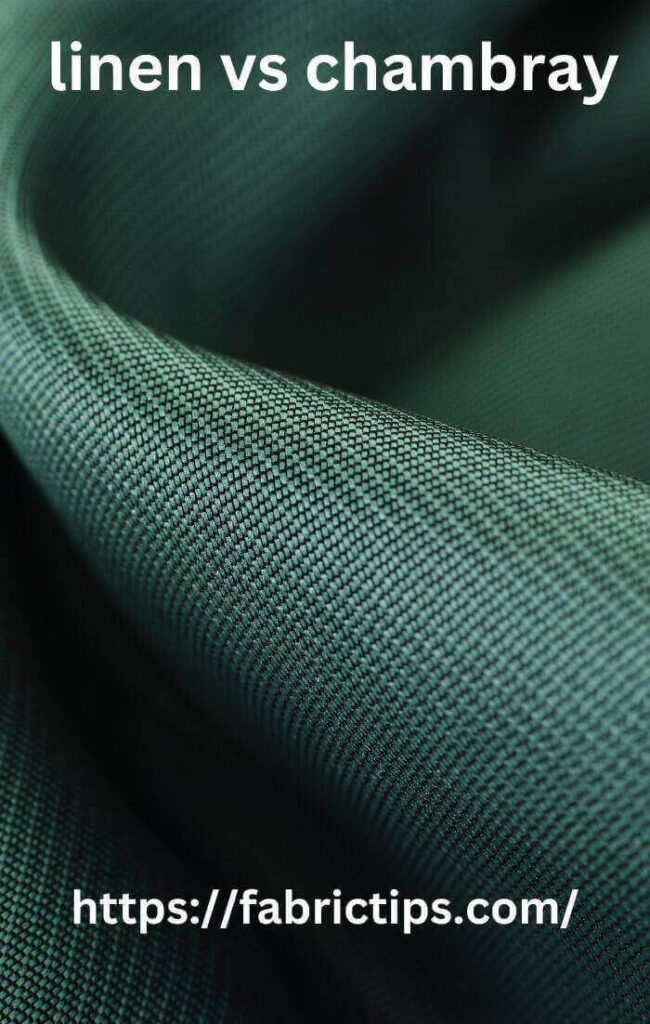Last Updated on December 13, 2025 by Wahid
Imagine stepping into an important meeting. You reach for a crisp, polished shirt that exudes confidence and professionalism. The fabric choice for your shirt can make all the difference in these scenarios. Here’s where understanding poplin and pinpoint fabrics comes in.
Poplin vs Pinpoint: what are the differences and who is the winner? Poplin and pinpoint are both types of woven fabrics commonly used in shirts and other garments. They share a fundamental weave structure called a basket weave, where one horizontal yarn (weft) crosses over two vertical yarns (warp) in a repeating pattern.
Poplin and Pinpoint share this basic structure, but their construction differs in subtle ways, which translate into different visual and textural characteristics. It’s important to understand these distinctions when choosing fabrics so your outfit reflects both style and comfort.
Poplin Vs. Pinpoint: Head-to-Head Comparison Chart
| Feature | Poplin | Pinpoint |
| Weave Structure: | Basket weave | Basket weave with finer yarns and tighter construction |
| Appearance: | Smooth, uniform surface with a slight sheen | More subtle texture with a matte finish |
| Feel: | Crisp and structured | Slightly softer and more comfortable |
| Opacity: | Generally good, some lightweight options might require layering | Typically higher opacity due to denser weave |
| Applications: | Dress shirts, formal wear, jackets, some homeware (sheets, tablecloths) | Dress shirts, casual shirts, some loungewear |
| Formality: | More formal | Slightly less formal than poplin, offers a balance of structure and comfort |
| Wrinkle Resistance: | Slightly more wrinkle-resistant due to looser weave | May wrinkle more easily due to tighter weave |
| Breathability: | Good | Good, might trap slightly more heat due to tighter weave |
| Care: | Machine-washable on gentle cycle, cool water, mild detergent, low heat drying or air drying preferred | Machine-washable on gentle cycle, cool water, mild detergent, low heat drying or air drying preferred |
| Ironing: | Can be ironed on low heat setting, preferably inside out | Can be ironed on low heat setting, preferably inside out |
Additional Notes:
- Both poplin and pinpoint are typically made from cotton, but blends with other fibers like polyester are possible.
- The specific characteristics of each fabric can vary slightly depending on the quality and weight of the yarn used.
Choosing Between Poplin and Pinpoint:
- For a crisp, polished look, poplin is a great choice.
- For a touch of comfort in formal wear or a slightly more refined casual shirt, pinpoint is ideal.
- Consider the desired level of formality, feel, and application when making your selection.
Poplin Vs Pinpoint: In-Depth Look

Poplin Weave:
The foundation of both poplin and pinpoint lies in the basket weave. Imagine a simple checkerboard pattern created by weaving yarns: one horizontal yarn (weft) passes over and under alternating vertical yarns (warp). In Poplin, this basic structure takes center stage.
- One Over, Two Under: A single weft yarn consistently crosses over one warp yarn and then under two warp yarns, creating a repetitive pattern.
- Crisp and Smooth: This straightforward construction results in a smooth, flat surface with a slightly pronounced horizontal texture. You can visualize the individual weft threads lying side-by-side, contributing to the poplin’s crisp and structured feel.
Pinpoint Weave:
Pinpoint takes the basket weave concept and refines it for a more subtle effect. Here’s how it elevates the poplin structure:
- Finer Yarns: Pinpoint utilizes significantly finer yarns compared to poplin. Imagine thinner threads creating a denser weave.
- Tighter Construction: By using finer yarns, the weaver can pack more threads into the same space, resulting in a tighter weave structure. This translates to a smaller “pinpoint” effect, where the individual intersections of yarns are less pronounced.
Poplin Vs Pinpoint: Key Differences

While Poplin and Pinpoint share the basket weave foundation, their subtle variations in construction translate into distinct properties that influence their ideal applications.
Appearance:
- Poplin: Poplin boasts a smooth, uniform surface with a slight sheen. This sheen is a result of the thicker weft yarns catching the light at specific angles.
- Pinpoint: Pinpoint offers a more subtle texture compared to poplin. The finer yarns and tighter weave create a slightly matte finish, appearing less shiny and with a more refined look.
Feel:
- Poplin: Due to the thicker yarns and slightly looser weave, poplin has a crisp and structured feel. This characteristic makes it ideal for tailored garments that need to hold their shape.
- Pinpoint: The finer yarns and tighter weave of pinpoint contribute to a slightly softer and more comfortable feel compared to poplin. This added comfort makes it a good choice for casual shirts and loungewear.
Opacity:
- Poplin: Poplin generally offers good opacity, meaning it’s not see-through. However, some very lightweight poplin fabrics might require layering for complete coverage.
- Pinpoint: Pinpoint typically boasts higher opacity than poplin due to the denser weave structure. This denser weave allows less light to pass through, making it a good choice for garments that don’t require additional layering for modesty.
Applications:
Understanding these properties helps guide your fabric choice for different applications:
- Poplin: Poplin’s crisp structure makes it a popular choice for dress shirts, formal wear like suits and blazers, and even some jackets. Its smooth surface allows for cleaner lines and printing, making it versatile for various garment styles. Poplin can also be found in some homeware like bed sheets and tablecloths.
- Pinpoint: Pinpoint excels in dress shirts where a balance of structure and comfort is desired. It also shines in casual shirts, offering a slightly more polished look than some other casual fabrics. Additionally, pinpoint’s comfortable feel makes it suitable for some loungewear applications.
Choosing the Right Fabric: Factors to Consider

Now that you understand the key differences between poplin and pinpoint, here’s how to translate this knowledge into selecting the perfect fabric for your needs:
1. Level of Formality:
- Poplin: For a crisp and polished look ideal for formal occasions, poplin is your go-to choice. Its structured nature creates clean lines and a professional appearance, making it perfect for dress shirts, suits, and blazers.
- Pinpoint: While still polished, pinpoint offers a slightly more relaxed feel compared to poplin. This makes it a great option for dress shirts where you want a touch of comfort without sacrificing formality. Pinpoint can also elevate casual shirts by adding a subtle sophistication.
2. Desired Feel:
- Poplin: If you prioritize a crisp and structured feel that holds its shape, poplin is the way to go. This characteristic is ideal for tailored garments that need to drape well and maintain clean lines throughout the day.
- Pinpoint: For a softer and more comfortable experience, pinpoint takes the lead. The finer yarns and tighter weave create a fabric that feels gentle against the skin, making it a great choice for casual shirts and loungewear where comfort is key.
3. Application:
Matching the fabric to the intended use ensures optimal performance:
- Poplin: Poplin’s structured nature makes it perfect for tailored garments like dress shirts, suits, and blazers. Its smooth surface allows for printing and intricate designs, making it versatile for various styles. Additionally, you might find poplin used in some homeware like bed sheets and tablecloths where a crisp and durable fabric is desired.
- Pinpoint: Pinpoint excels in dress shirts where a balance of structure and comfort is needed. It drapes well while offering a slightly softer feel compared to poplin. Pinpoint also shines in casual shirts, adding a touch of sophistication to your everyday attire. Additionally, pinpoint’s comfortable nature makes it suitable for some loungewear applications like joggers or sweatpants where a balance between relaxation and style is desired.
However, by considering these factors, you can confidently choose between poplin and pinpoint, ensuring your garments not only look great but also feel comfortable for the occasion.
Beyond Poplin & Pinpoint: Delving Deeper into Shirt Fabrics
While poplin and pinpoint offer a solid foundation for shirting, the world of fabrics boasts a rich tapestry of weaves and textures. Here, we delve deeper into some popular options, expanding your wardrobe possibilities:
1. Twill: The Diagonal Charmer
- Weave Structure: Twill is characterized by its diagonal pattern. The weft yarn weaves diagonally across the warp yarns, creating a distinct visual texture. This diagonal “drift” can be subtle or more pronounced depending on the fabric’s weight and construction.
- Look and Feel: Twill fabrics generally offer a more casual and relaxed feel compared to poplin and pinpoint. They tend to drape well and have a slightly sturdier body.
- Applications: Twill’s versatility extends beyond shirting. It’s a popular choice for chinos, workwear pants, and even some jackets. Lighter weight twills can be used for creating comfortable and stylish shirts.
2. Oxford: The Textured Classic
- Weave Structure: Similar to poplin, oxford utilizes a basket weave, but with a twist. Oxford incorporates thicker yarns for both the weft and warp, creating a more textured and slightly raised surface. This raised texture is achieved by weaving additional weft threads over multiple warp yarns at specific intervals.
- Look and Feel: The raised texture of Oxford fabric gives it a distinct visual character and a slightly more casual aesthetic compared to poplin and pinpoint. It offers a comfortable, slightly rougher feel against the skin.
- Applications: Oxford reigns supreme in the realm of casual button-down shirts. Its timeless appeal and textured look make it a wardrobe staple for many.
3. Chambray: The Light and Airy Option
- Weave Structure: Chambray utilizes a plain weave, the most basic weave structure where one weft yarn alternates over and under one warp yarn. However, chambray uses colored weft yarns against a white or light-colored warp, creating a distinct two-toned effect.
- Look and Feel: Chambray fabrics are typically lightweight and breathable, making them ideal for warmer weather. They offer a casual and relaxed look with a subtle hint of color. The feel is soft and comfortable, perfect for everyday wear.
- Applications: Chambray shines in casual shirts, dresses, and even lightweight jackets. Its light and breezy nature makes it a popular choice for spring and summer wardrobes.
4. Linen: The Natural Choice for Warm Weather
- Fiber Content: Linen is a natural fiber derived from the flax plant. Unlike the cotton-based fabrics discussed earlier, linen offers unique properties.
- Look and Feel: Linen has a characteristic wrinkled look that adds to its charm. It’s known for its exceptional breathability and moisture-wicking capabilities, making it ideal for hot and humid weather. The feel is crisp and slightly rough, but softens with washing and wear.
- Applications: Linen shirts are a perfect choice for staying cool and comfortable during summer. Linen can also be used for dresses, pants, and jackets, offering a natural and breathable alternative to traditional fabrics.
5. Flannel: The Cozy Champion
- Weave Structure: Flannel can utilize various weave structures, but it’s most commonly associated with a plain weave. The key characteristic of flannel is its napped finish. During finishing, the fabric is brushed to raise tiny fibers on the surface, creating a soft and fuzzy texture.
- Look and Feel: Flannel is all about warmth and comfort. Its soft, napped surface provides excellent insulation, making it ideal for colder weather. The look is typically casual and relaxed, often featuring plaid or checkered patterns.
- Applications: Flannel reigns supreme in shirts and jackets designed for cooler weather. It’s also used for loungewear like pajamas and sweatpants, offering ultimate comfort and warmth.
Ultimately, this exploration provides a glimpse into the diverse world of shirting fabrics beyond poplin and pinpoint. Consider these options when building your wardrobe, and don’t be afraid to experiment with different textures and looks to find what best suits your style and needs.
FAQ – Poplin vs. Pinpoint
Here are some of the most common questions about poplin and pinpoint fabrics, gleaned from Reddit, Quora, and other online communities:
Q-1. Is there a big difference between Poplin and Pinpoint?
Answer: They share a basket weave structure, but Pinpoint takes it a step further. It uses finer yarns and a tighter weave, resulting in a subtler texture and a slightly matte finish compared to Poplin’s smoother, slightly shiny surface. Pinpoint also feels a touch softer and more comfortable than poplin.
Q-2. Which one is more formal, poplin or pinpoint?
Answer: Poplin, with its crisp structure, leans more formal. It’s a great choice for dress shirts and tailored garments. Pinpoint offers a balance of structure and comfort, making it suitable for dress shirts where a touch of casualness is desired, or for more elevated casual shirts.
Q-3. Is Poplin or Pinpoint more wrinkle-resistant?
Answer: Poplin’s slightly looser weave and thicker yarns might offer a bit more wrinkle resistance. However, both fabrics can wrinkle, and following proper care instructions is crucial for minimizing wrinkles.
Q-4. Which fabric is better for hot weather?
Answer: Both are breathable fabrics made from cotton, but Pinpoint’s slightly tighter weave might trap a touch more heat. If ultimate breathability is a priority, consider lighter weight options in either poplin or pinpoint, or explore fabrics like linen for exceptional hot-weather comfort.
Q-5. Which fabric is more wrinkle-resistant: poplin or pinpoint?
Answer: Poplin, with its slightly looser weave and thicker yarns, tends to be slightly more wrinkle-resistant compared to pinpoint. However, both fabrics can wrinkle, especially after wearing or sitting for extended periods.
Q-6. How do I care for poplin and pinpoint garments?
Answer:
- Reading the Label: Always prioritize the care instructions on the garment label for specific washing and drying recommendations.
- General Care: Generally, both fabrics can be machine-washed on a gentle cycle with cold water. Opt for a mild detergent and avoid harsh chemicals that can damage the fibers.
- Drying: Minimize shrinkage by tumble drying on low heat or air drying whenever possible.
Q-7. How can I tell if a garment is made from poplin or pinpoint?
Answer:
- Visual Inspection: Pinpoint’s finer yarns and tighter weave create a slightly more subtle texture and a matte finish compared to Poplin’s smoother surface with a slight sheen.
- Feel: Pinpoint might feel slightly softer due to the finer yarns. However, this distinction can be subtle, and relying solely on feelings might be challenging.
- Garment Label: The best way to identify the fabric is by checking the garment label. It should specify the fabric composition (e.g., 100% cotton poplin or cotton pinpoint).
Q-8. Is Poplin and Pinpoint breathable?
Answer: Yes, both Poplin and Pinpoint are breathable fabrics made from cotton. The breathability might vary slightly depending on the specific weave tightness and yarn thickness. However, both generally allow good air circulation, making them comfortable for everyday wear.
Q-9. Can I iron poplin and pinpoint garments?
Answer: Yes, you can iron both fabrics. However, it’s usually not necessary. If ironing is needed:
- Use Low Heat: Always use a cool iron setting to avoid damaging the fabric.
- Turn Garment Inside Out: Ironing on the inside helps protect the surface of the fabric.
- Consider a Pressing Cloth (Optional): A pressing cloth between the iron and the fabric can offer additional protection.
Conclusion: Unveiling the Perfect Shirt with Poplin or Pinpoint
Our journey through Poplin vs Pinpoint fabrics hopefully equips you to make informed choices for your wardrobe. Understanding these differences empowers you to choose the perfect fabric. For a crisp, polished look, poplin is your go-to. If you desire a touch of comfort in formal wear or a slightly more refined casual shirt, pinpoint takes center stage. Ultimately, consider the desired level of formality, feel, and application to select the fabric that elevates your style and ensures long-lasting comfort.
Hence, beyond poplin and pinpoint, remember the vast textile landscape. Explore options like twill for a casual touch, oxford for a textured classic, chambray for a light and airy feel, linen for natural breathability, or flannel for ultimate comfort in cooler weather.
With this knowledge, you can confidently navigate the world of fabrics and curate a wardrobe that reflects your unique style and keeps you feeling comfortable throughout the year. Happy exploring!


